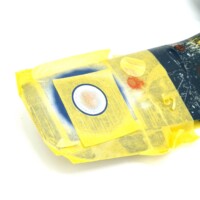Thank you very much! I've been meaning to pick up those books actually, the Corsair: A Comprehensive Guide is one I do have that I recommend if you don't have already. That '277' is an interesting one too as its one of the prototype F4U-1Cs, the rare time it isn't in overall sea blue.
Those gun boxes are interesting, I remember first learning about it with the below photo which would make an interesting diorama if anyone is interested in battle-damaged aircraft.
Speaking of the undercarriage, KD431 has them in all blue. I didn't snap a photo but these are all painted up on my end, just needing a tad of weathering and then I'll snap a pic.
Roundels, Flaps and Fabric
Firstly our Corsair has chipping done to the flaps. Very beaten up, clearly lots of foot traffic here despite it not being the proper way of entering the aircraft due to the lack of the F4U-4 style of foot hole in the right inboard flap.
Fabric was then painted on the aircraft in a lighter shade, whilst it's not too noticeable on the original fabric pieces it's something that is worth doing. I feel it went a bit too far on the left wing, but I can tone this back a bit with weathering. The right side was done purposely brighter, this is due to the right wing fabric being removed during KD431s time as a student training aid to allow easy visuals of the interior of the wing. Fabric was put here when the aircraft was given to Yeovilton museum, and replaced and repainted during the early 2000s restoration as its not original anyways. I do plan on adding the holes to the left wing that the aircraft currently has.
Fabric on the flaps was tried but masking tape caused a big rip of the chipping fluid, I guess the paint wasn't as thick here as I had done on the wing so these are yet to be done.
Roundels were then added, a few issues here with white still being visible. This is largely due to me not wanting to put too much paint on the fabric surfaces to make them appear a bit brighter, this can all be fixed up. I also made my own mask to expand the white section, the book doesn't list the size but it seems to be around double that of the type C roundel mask set I have. As a side I found these quite difficult to work with this time when I had no issues with the fuselage masks, maybe due to it being bigger. Kubuki tape is nice but it doesn't hold its shape as well as vinyl masks do, so repositioning it a few time leads to some issues.
I've also gone ahead and properly glued on the elevators and engine, I've also glued down the engine panels. Whilst it doesn't sit
poorly with the panels not glued, as the instructions intend, there was enough of a gap to warrant them being glued. I'm not hugely proud of that engine under those panels anyways as I didn't fill in gaps and such on the cylinders that wouldn't be visible from the front.
E: Oh yeah, fuselage chipping was done. This wasn't a major affair compared to the wings. More chips were added to the engine access panels too, it looks a bit much but it seems to be that way based on one photo from above in the KD431 book. Makes sense, those panels would have been chucked around a fair bit.
Speaking of chipping that reminds me of an event I struck to the back of my brain, you may notice the left wing walkway is a bit red.
Needless to say an incident involving a 1/32 Corsair flipping into a bottle of tamiya red paint occurred, a few swear words later and the majority of damage was washed off before the paint dried. The rest was fixed with a light coat of sea blue but the chipping, now a light blue instead of silver, needed to be redone. Thankfully its not noticeable now and I was able to fix it, and that walkway will get redone later anyways as I mentioned before.
As a further side the flaps haven't got walkways added as there's a handy rivet line right where it needs to go, meaning I already have a reference for the chipping.
1 additional image. Click to enlarge.
-

1. Custom mask made with a compass over the purchased ones. I'm actually very surprised how this came out as previous attempts with the compass didn't end up looking too circular.